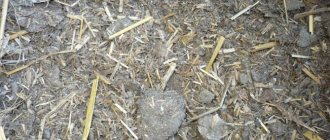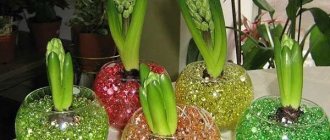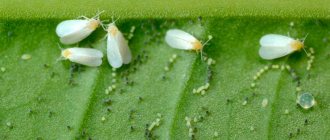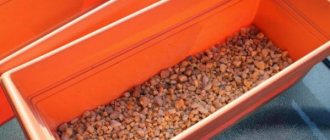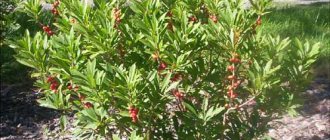My first acquaintance with hydrogel took place a long time ago. Back in the nineties, my husband brought funny multi-colored balls from Japan, which greatly increased in size when filled with water. They were supposed to be used for bouquets or for some other decorative purposes. Of course, at first it was funny, but then I got tired of playing and abandoned them, I don’t even remember where they went. But I recently returned to using hydrogel. I will tell you about my experience in this article.
Hydrogel instead of frequent watering - my experience of using it
Why is it needed?
Attention! Hydrogel is used mainly in the agricultural sector to provide plants with moisture during dry periods.
Its use reduces watering by 4-6 times, normalizes plant nutrition and prevents their dehydration. The material is used in garden beds, greenhouses and indoor floriculture. It improves soil properties and makes it easier to care for plants.
It can be used as a soil additive in flower pots to reduce the amount of watering. The substance can also be used as an independent substrate for rooting cuttings, flower arrangements or growing certain indoor plants.
Why did I need hydrogel
Just at the beginning of this year, I needed a product to reduce the number of waterings of containers with plants on the terrace.
I must say that beautiful compositions of plants in pots are my main hobby this season. But such a potted garden requires quite a lot of care. And most importantly, daily (or even several times a day) watering. Especially in such heat as it was at the beginning of summer.
It is not always possible to water several times a day. Previously, I used expanded clay, perlite or vermiculite to retain moisture in the soil, which also made the task much easier. But still this was clearly not enough.
And then, just in time, a hydrogel caught my eye in a store, and I decided to try using it for my flowerpots.
I really liked it. The earth mixed with hydrogel became like fluff. The plants grew well in it and did not require as frequent watering. In some cases, watering was reduced by almost half.
In addition, the hydrogel also absorbs nutrients from fertilizers and gradually and evenly releases them to the plants along with water. So the hydrogel also successfully solves the problem of frequent fertilizing, which inevitably arises due to the constant leaching of nutrients during frequent watering.
I also tried germinating seeds using hydrogel, which also worked great. Especially if the seeds are large, take a long time to germinate and require constant monitoring so that they do not dry out or, conversely, become moldy. With hydrogel all these problems disappeared.
Planting seedlings is a pleasure: with a teaspoon we take a piece of hydrogel along with the root and place it in a new place.
The hydrogel is also very convenient for cuttings; you can add rooting-promoting preparations to it, and forget about constantly monitoring the humidity of the substrate.
According to manufacturers, the hydrogel is capable of absorbing from 100 to 400 g of water per 1 g of granules. © Anna Gower
What domestic crops are used in growing?
Hydrogel is an excellent additive for flowers that require frequent watering and is suitable for all plants that love a humid environment. For flowers with a rare watering regime, for which water is not the main priority for growth, its use is not recommended. The substance is absolutely not suitable for cacti and other succulents.
As for planting in pure hydrogel, ficus, dieffenbachia, ivies, arrowroot, dracaenas, philodendrons, syngonium, chlorophytum and ferns are suitable for this. Cacti, succulents and epiphytes are not suitable for such planting.
Application and methods of preparing hydrogel
The areas of application of hydrogel are quite significant. The material is widely used in gardening work . Thus, a polymer substrate added to clay soils improves the structure of the soil and helps protect plants from excess moisture and rotting of the root system. The use of this polymer in dry soil improves the water supply to the root system.
The hydrogel is also used as a substrate for germinating seeds and growing flower seedlings.
For seedlings and planting plants in open ground, 1 g of polymer powder is required per 1 kg of soil. The pre-crystalline substance is diluted in clean water and allowed to swell for several hours. Then it is added to the soil and mixed thoroughly so that all areas of the soil can get access to moisture. As a result of using hydrogel, fertilizing and watering are reduced by 3–4 times.
Seeds can also be germinated in pure hydrogel without soil. For this purpose, the swollen polymer is thoroughly crushed and placed in shallow containers in a layer of up to 1.5 cm . When planting, the seeds are lightly pressed down, then these containers are covered with film and the darkened area is removed. After the seeds germinate, they are planted in soil with a portion of the hydrogel.
Aqua soil in its pure form without soil admixture is used for keeping indoor plants. To do this, it is pre-soaked in water with fertilizers and left for 12 hours. After which the granular filler is placed in glass vessels where flowers are later planted. It is not recommended to use crystal glassware for planting, as crystal contains lead oxides.
Plants for decorative filler are chosen small in size , which can be well strengthened in aqua soil. They must also be moisture-loving and shade-tolerant. Bamboo, which in nature actually grows in water, feels best in such an environment. For other types of plants, fertilizers must be added. The service life of decorative aqua soil does not exceed 2 years.
The polymer material also serves as a filler to preserve bouquets of cut flowers and thus helps to increase the lifespan of plants.
Due to its properties of retaining moisture for a long time, the polymer is used when transporting plants. The instructions for use will tell each buyer more about how the hydrogel can and should be used.
Disadvantages of hydrogel
- Under the influence of sunlight, water in glass vessels with aquasoil granules begins to bloom and acquire an unpleasant odor. Therefore, it is better to install indoor plants planted in decorative filler in shaded areas.
- Multi-colored polymer capsules quickly fade in bright light and lose their decorative appearance.
- The top layer of aquasoil granules in which the flowers are planted dries out in the air, while at the bottom of the vessel the crystals become moldy as a result of stagnation of water. Therefore, they must be washed periodically in running water.
The use of hydrogel greatly facilitates plant care and saves time and necessary resources. Such material can speed up the life processes of plants without causing harm to the environment.
Advantages and disadvantages
This material, like any other, has its pros and cons. Its advantages include the following:
- Long period of use. When soaked, store in the refrigerator in an airtight container. It can be used in soil for up to 5 years.
- Can be used to decorate a flower pot - there are colored granules.
- Protects against rot and fungal diseases.
- Makes it easier to care for plants by reducing the frequency of watering.
- Improves soil composition due to high aeration.
- Harmless to humans and plants.
- Resistant to temperature changes.
- The beneficial substances present there are not washed out of the soil.
Hydrogel also has disadvantages that you should also be aware of:
- It is not suitable for all types of indoor plants, but only for moisture-loving ones.
- May become moldy in direct sunlight.
- Multi-colored capsules fade in the sun and lose their decorative effect.
- The material does not contain nutrients and requires their regular application.
Types of hydrogel
There are two main types of hydrogel, which differ in their composition, density, appearance and have different areas of application.
A soft , colorless polymer serves to moisturize the root system of plants and acts as a soil loosening agent. The hydrogel has a jelly-like structure, so the roots, penetrating into the granules, easily absorb water and microelements dissolved in it. Thus, with the help of this polymer material it is possible to lengthen the periods between watering plants.
In the process of absorbing water, the hydrogel increases in volume by 10–15 times , due to which it can retain a large amount of moisture (10 g of granules holds up to 2 liters of water), which is gradually released to the roots of plants as needed. At the same time, the roots of the plant do not rot from waterlogging, since excess water is absorbed by the polymer.
Aqua soil is a hydrogel with a denser composition; it is produced in the form of colored granules of various shapes (balls, cubes, pyramids).
Since the structure of such a polymer is more dense, it is more difficult to absorb moisture. Such crystals are used mainly as temporary soil or for decorative purposes as a filler for indoor flowers.
You can use hydrogel for plants repeatedly , just dry it well. Despite the fact that over time (after 1 - 1.5 years) the decorative qualities of this polymer deteriorate, the ability to absorb and retain water is retained. Therefore, at the end of its service life (5 years), the polymer is mixed with the soil, where it continues to perform its functions for several more years, and then breaks down into environmentally friendly components (carbon dioxide, water and ammonium).
The polymer is non-toxic and can retain its properties in the soil at low and high temperatures for 5 years. Hydrogel for plants is not harmful, since its production uses environmentally friendly material (polyacrylamide), in which there are no conditions for the proliferation of harmful microorganisms.
How to choose the right one?
Important! The choice of material is determined by the purpose for which it is purchased.
There are different types of hydrogel.
Agrarian
In the form of colorless granules or powder. It is universal and economical, but does not have a decorative appearance. Used as a useful additive when mixed with soil.
Hydrogel balls Aquagrunt
Colored, dense gel balls, larger in diameter. It is used for decorating or growing small indoor plants in it.
Reference. When using the substance as a primer, it must be replaced with a fresh one every couple of years.
What is hydrogel?
Let’s dot the i’s right away. On the market for gardening products you can often find so-called aqua soil, sold in the form of multi-colored granules, which, when swollen, turn into bright transparent balls. Sellers often call it hydrogel, thereby attributing to aqua soil the beneficial properties of a “garden assistant” and misleading gullible buyers.
Aqua soil has only decorative qualities. It cannot be used for growing plants, but you can create compositions, for example, by placing multi-colored balls instead of water in a vase with fresh flowers.
The “correct” granular hydrogel in dry form is a fine white crumb. Solid grains have different shapes, and after they absorb moisture, they increase 200-300 times and transform into a granular jelly-like mass. This hydrogel is used as a substrate or added to the soil: plant roots penetrate into the gel “reservoir” and take as much moisture as necessary. At the same time, the water in the gel does not stagnate or evaporate.
Liquid hydrogel is not used very often in our area. Before “cooking” it looks the same as a regular hydrogel, but after adding water it does not swell, but dissolves in it. Seeds are soaked in liquid hydrogel before sowing to speed up the germination of seedlings. But you shouldn’t germinate seeds in it: the liquid hydrogel envelops the seed, making it difficult for oxygen to reach.
How to use for flowers?
Growing indoor plants with hydrogel is easy. There are different options for using the substance, which depend on the technique of its application to the soil.
- Even mixing - great for potted flowers. Before use, the granules are soaked in water - after a few hours they will increase significantly in size. The finished granules are mixed with soil in a ratio of 1:5 and the plants are planted in the prepared soil. The growing roots will penetrate the hydrogel and become saturated with moisture.
- You can also add hydrogel to pots with already planted flowers. To do this, deep holes are made in the soil, into which a little dry matter is poured and watered generously. Under the influence of moisture, the granules swell and become an additional container for moisture.
- To root cuttings, you can use hydrogel in its pure form, without mixing it with soil. It is enough to fill the container with soaked gel balls and place the cutting in them.
- When planting indoor plants in pure hydrogel, you need to take a low specimen with a developed root system. After the substance swells, liquid fertilizer is added to it. The plant is carefully removed from the ground and the roots are washed under running water, then it is placed in a pot and the gel is added.
Proper sowing of plant seeds in hydrogel
Polymer capsules can be successfully used in seed germination. Manufacturers do not share this method, but gardeners actively use it.
First you need to soak the hydrogel, drain off the excess liquid, and grind the remaining mass through a sieve or grind in a blender. The result will be something like a homogeneous “jelly”, which will be evenly distributed along the bottom of a shallow and wide vessel. The hydrogel layer should be 1-2 cm.
Seeds are laid out on it, which need to be pressed down using a toothpick or match. After planting all the seeds, cover the container with film and wait for them to sprout. After seed germination, when the first leaves appear, sprouts and pieces of hydrogel are transferred to the soil.
Instructions for using aquagel
After purchasing aquagel, it cannot be used immediately. And before planting a houseplant, you need to prepare the aqua soil.
Preparing aquagel for planting
Aquagel is sold in the form of multi-colored balls. To use it, the balls need to be prepared:
- remove from packaging and pour into prepared container;
- add 0.5 liters of ordinary tap water to the bowl with balls;
- leave the aquagel in this form for a day;
- drain off the remaining liquid that has not penetrated into the balls.
Using aqua soil for plants
After the above measures, the artificial soil will be ready for use. It can be used without any problems as a soil for a florarium.
Planting a plant in aqua soil
The pre-prepared balls are placed in a container where the plant will be planted in the future. To do this, the flower is carefully removed from the ground. The roots are washed thoroughly.
Attention!
You should ensure that no substrate remains on the roots, otherwise the entire appearance of the flower arrangement may deteriorate.
After washing the roots, the indoor plant is immersed in a container in aqua soil. If the flower has a long stem, then first a little hydrogel is poured onto the bottom of the container, then the root system of the plant is placed on top. After this, the root is completely covered with aquasoil. Planting a flower in this way will give the plant stability.
Important!
If there are children and animals in the house, then pots with aqua soil should be placed in places inaccessible to them. Because if swallowed, they can be harmful to their health.
Pros and cons of aquasoil
The use of this eco-soil has its advantages and disadvantages. The positive points include:
- beautiful design of the flower, and, therefore, giving
- a certain color scheme for the interior;
- saturating the flower with moisture for some time;
- the purchased balls are small in size and require little space to store them;
- replant flowers growing in aqua soil and without dirt;
- if you need to leave for a long time, the hydrogel will keep the flowers in their original form and saturate their roots with moisture in time.
Aqua soil
In addition to its advantages, aqua soil also has significant disadvantages, these are:
- lack of nutrients needed by any plant;
- the need to constantly fertilize indoor flowers, otherwise they will not fully grow and develop;
- To grow plants in aqua soil, you need pots with good aeration, otherwise the root system may rot;
- when exposed to sunlight, the top layer of the balls may become covered with a green coating;
- moisture from the top layer of granules evaporates very quickly, which may require regular spraying.
What is aqua soil?
Aqua soil is a polymer. Capable of absorbing and retaining a sufficiently large volume of water for a long time. It is produced in the form of balls, which can be either colored or transparent. After absorbing the liquid, the balls increase several times in size. If the need arises, the moisture that the aqua soil has absorbed will be given back to the roots.
Aqua soil does not contain substances beneficial to the plant. Its purpose is to absorb moisture and gradually saturate the root system with liquid. Flowers will receive only those nutrients contained in the absorbed water.
Aqua soil when making bouquets
Aqua soil is what cut flowers simply need in a bouquet. It looks very beautiful in a vase. And even capricious roses last much longer in such a substrate than in ordinary water. Their cut does not rot, and they have enough moisture to maintain a decent appearance.
Important!
Before placing the bouquet in aqua soil, the substrate must be washed with water every 2 days, as well as the plant stems themselves. This is done to remove mucus and eliminate odor in the vase.
The basic principle of hydrogel operation is optimization of hydration and nutrition regimes
If you monitor your plants, their death due to stagnation of moisture or drying out of the substrate is rare, but even short-term deviations of humidity in both directions from the optimum lead to a significant disruption of their normal development.
The nutritional regime is directly related to the humidity regime. The simplest example: plants are not able to use fertilizers “in dry form”, therefore, with a lack of moisture, the normal consumption of nutrients is disrupted. The plant is “starving”, although fertilizers have been applied to the soil.
And changes in humidity and disturbances in the normal diet lead to plants blooming poorly, quickly aging and withering. In large greenhouses, such problems have long been solved using drip irrigation. For amateurs, the only alternative is to use hydrogel.
I. Dynamics of soil moisture without adding hydrogel:
Schematic dynamics of soil moisture. “Clouds” are the moments of watering, the lower scale is time. The period of time during which optimal conditions are created for the growth and development of plants (highlighted in green on the lower scale) is very short. The supply of water and food is of a pronounced pulsating nature.
I - overwatering. Water occupies aeration pores and plant growth is inhibited. With prolonged stagnation of moisture - death II - optimal humidity range. Normal growth and development of plants III - lack of water. Plant growth and development stops
II. Moisture content when applying Evabeon® hydrogel:
I - overwatering. The hydrogel absorbs excess water, freeing up the aeration pores. II - optimal humidity range. Normal growth and development of plants III - lack of water. The hydrogel releases water to the plant roots.
When applying Evabeon® hydrogel, the supply of water and nutrition is constant. The plant is in comfortable conditions all the time. Therefore, it blooms more abundantly and longer, develops faster, increases yield and suffers less.

